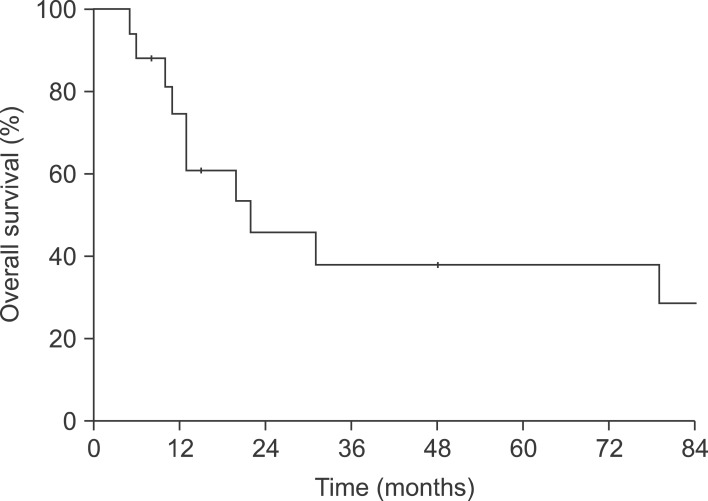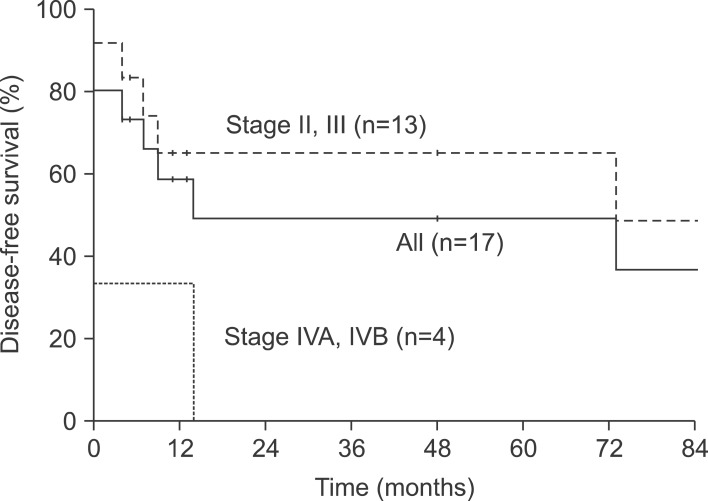Korean J Hepatobiliary Pancreat Surg.
2011 Aug;15(3):152-156. 10.14701/kjhbps.2011.15.3.152.
Treatment outcomes and prognostic factors of gallbladder cancer patients after postoperative radiation therapy
- Affiliations
-
- 1Department of Radiation Oncology, Seoul National University College of Medicine, Seoul, Korea. swha@snu.ac.kr
- 2Department of Surgery, Seoul National University College of Medicine, Seoul, Korea.
- 3Department of Internal Medicine, Seoul National University College of Medicine, Seoul, Korea.
- 4Institute of Radiation Medicine, Medical Research Center, Seoul National University, Seoul, Korea.
- KMID: 2130986
- DOI: http://doi.org/10.14701/kjhbps.2011.15.3.152
Abstract
- BACKGROUNDS/AIMS
To investigate survival rates and prognostic factors of patients with gallbladder cancer who were treated with surgery and postoperative radiation therapy.
METHODS
Seventeen gallbladder cancer patients who received surgery and postoperative radiotherapy from October 1989 to April 1998 were included in this retrospective study. Five patients had stage II, 8 patients had stage III, and 4 patients had stage IV disease according to the 1997 American Joint Committee on Cancer (AJCC) staging. All patients received > or =40 Gy of postoperative radiotherapy with a daily dose of 2.0 Gy/fraction and 15 patients received concurrent chemotherapy. An analysis was performed for the endpoints of overall and disease-free survival.
RESULTS
Of the 17 patients, 13 had no residual disease (R0), 1 had microscopic residual disease (R1), and 3 had macroscopic residual disease (R2) after surgery. Among patients with no residual disease, 4 had locoregional recurrences during the follow-up period. One patient with microscopic residual disease had local recurrence. The 5-year overall survival rate was 38.2%. The median overall survival time was 21 months and the median disease-free survival time was 12 months. Old age (> or =60 years old), female gender, a high pathological stage (> or =IVA), and the presence of residual disease after surgery were significant prognostic factors for disease-free survival.
CONCLUSIONS
Despite a high proportion of patients with advanced disease and macroscopic residual disease, the prognosis of gallbladder patients who had postoperative radiotherapy is encouraging. Additional investigation to improve the loco-regional control of gallbladder cancer patients with adverse prognostic factors is warranted.
Keyword
MeSH Terms
Figure
Reference
-
1. Duffy A, Capanu M, Abou-Alfa GK, et al. Gallbladder cancer (GBC): 10-year experience at Memorial Sloan-Kettering Cancer Centre (MSKCC). J Surg Oncol. 2008; 98:485–489. PMID: 18802958.
Article2. Mahantshetty UM, Palled SR, Engineer R, Homkar G, Shrivastava SK, Shukla PJ. Adjuvant radiation therapy in gall bladder cancers: 10 years experience at Tata Memorial Hospital. J Cancer Res Ther. 2006; 2:52–56. PMID: 17998675.
Article3. Gold DG, Miller RC, Haddock MG, et al. Adjuvant therapy for gallbladder carcinoma: the Mayo Clinic Experience. Int J Radiat Oncol Biol Phys. 2009; 75:150–155. PMID: 19297105.
Article4. Park JI, Kim JS, Kim KH, et al. Analysis of prognostic factors affecting survival in patients with gallbladder cancer. Korean J Hepatobiliary Pancreat Surg. 2010; 14:173–183.5. Czito BG, Hurwitz HI, Clough RW, et al. Adjuvant external-beam radiotherapy with concurrent chemotherapy after resection of primary gallbladder carcinoma: a 23-year experience. Int J Radiat Oncol Biol Phys. 2005; 62:1030–1034. PMID: 15990005.
Article6. Kresl JJ, Schild SE, Henning GT, et al. Adjuvant external beam radiation therapy with concurrent chemotherapy in the management of gallbladder carcinoma. Int J Radiat Oncol Biol Phys. 2002; 52:167–175. PMID: 11777635.
Article7. Kim WS, Choi DW, You DD, Ho CY, Heo JS, Choi SH. Risk factors influencing recurrence, patterns of recurrence, and the efficacy of adjuvant therapy after radical resection for gallbladder carcinoma. J Gastrointest Surg. 2010; 14:679–687. PMID: 20094817.
Article8. Jarnagin WR, Ruo L, Little SA, et al. Patterns of initial disease recurrence after resection of gallbladder carcinoma and hilar cholangiocarcinoma: implications for adjuvant therapeutic strategies. Cancer. 2003; 98:1689–1700. PMID: 14534886.
- Full Text Links
- Actions
-
Cited
- CITED
-
- Close
- Share
- Similar articles
-
- Reviewing the potential role of radiation therapy in gallbladder cancer: an update
- Cholelithiasis as a Risk Factor for Gallbladder Cancer
- Treatment Results and Prognostic Factors of T3 Supraglottic Cancer
- The Results of Postoperative Radiation Therapy in the Rectal Cancer
- Multidisciplinary Therapeutic Approach to Gallbladder Cancer



